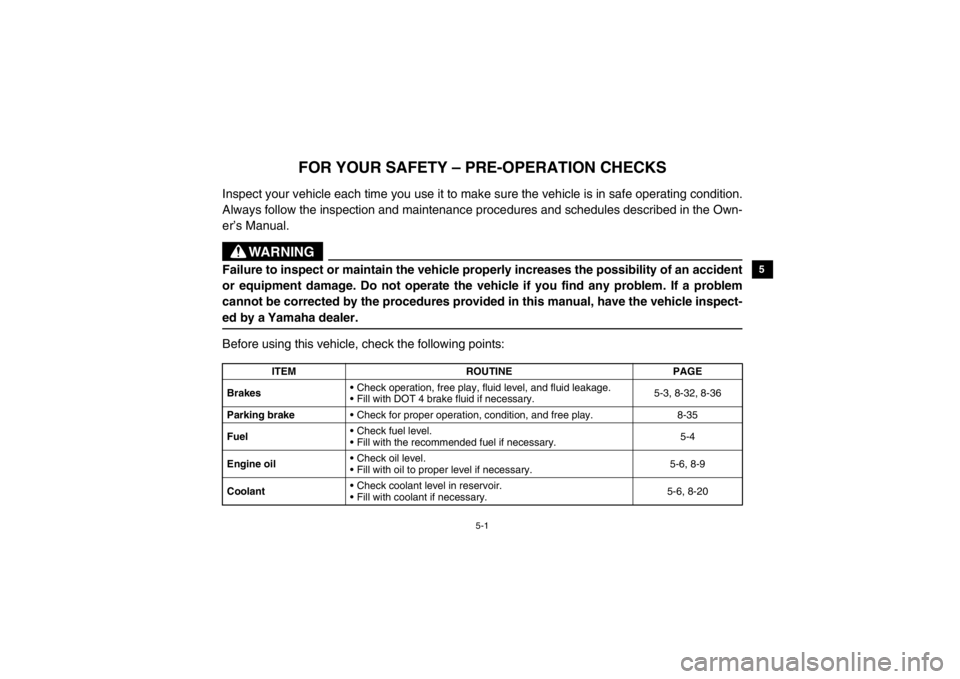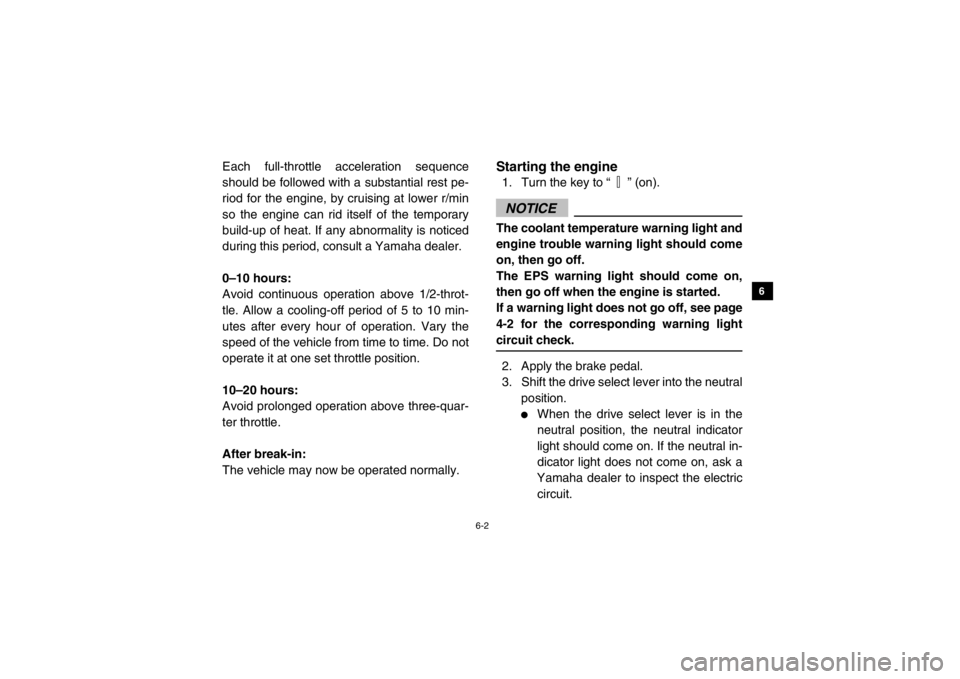Page 48 of 180
4-16
4
5
6
7
8
9
10
11
12
13
14
EVU00280Parking brake leverThe parking brake lever is located at the right
side of the steering wheel. Setting the parking
brake lever will help keep the vehicle from
moving while parked.
To set the parking brake, pull the lever rear-
ward completely.
To release the parking brake, pull rearward on
the lever, press the release button, and then
push the lever all the way forward.
Spring tension helps return the lever to the re-
leased position.1. Parking brake lever 2. Release button
EVU00290Drive select leverThe drive select lever is used to shift the vehi-
cle into the low, high, neutral, and reverse po-
sitions. (Refer to page 6-4 for the drive select
lever operation.)1. Drive select lever
12
1
1XP7B_EE.book Page 16 Tuesday, February 4, 2014 3:40 PM
Page 63 of 180

5-1
1
2
3
45
6
7
8
9
10
11
12
13
14
EVU01200
1-FOR YOUR SAFETY – PRE-OPERATION CHECKS
Inspect your vehicle each time you use it to make sure the vehicle is in safe operating condition.
Always follow the inspection and maintenance procedures and schedules described in the Own-
er’s Manual.
WARNING
Failure to inspect or maintain the vehicle properly increases the possibility of an accident
or equipment damage. Do not operate the vehicle if you find any problem. If a problem
cannot be corrected by the procedures provided in this manual, have the vehicle inspect-
ed by a Yamaha dealer.Before using this vehicle, check the following points:
ITEMROUTINE PAGE
Brakes Check operation, free play, fluid level, and fluid leakage.
Fill with DOT 4 brake fluid if necessary. 5-3, 8-32, 8-36
Parking brake Check for proper operation, condition, and free play. 8-35
Fuel Check fuel level.
Fill with the recommended fuel if necessary. 5-4
Engine oil Check oil level.
Fill with oil to proper level if necessary. 5-6, 8-9
Coolant Check coolant level in reservoir.
Fill with coolant if necessary. 5-6, 8-20
1XP7B_EE.book Page 1 Tuesday, February 4, 2014 3:40 PM
Page 65 of 180

5-3
1
2
3
45
6
7
8
9
10
11
12
13
14
EVU00390Front and rear brakesBrake pedal
Check that there is no free play in the brake
pedal. If there is free play, have a Yamaha
dealer check the brake system. (See page
8-35.)
Check the operation of the brake pedal. It
should move smoothly and there should be a
firm feeling when the brakes are applied. If
not, have the vehicle inspected by a Yamaha
dealer.
Brake fluid level
Check the brake fluid level. Add fluid if neces-
sary. (See pages 8-33–8-34.)Brake fluid leakage
Check to see if any brake fluid is leaking out of
the pipe joints or the brake fluid reservoir. Ap-
ply the brakes firmly for one minute. If there is
any leakage, have the vehicle inspected by a
Yamaha dealer.
Brake operation
Check the operation of the brakes at the start
of every ride. Test the brakes at slow speed
after starting out to make sure they are work-
ing properly. If the brakes do not provide prop-
er braking performance, inspect the brake
system. (See pages 8-32–8-33, 8-35–8-36.)
Specified brake fluid: DOT 41XP7B_EE.book Page 3 Tuesday, February 4, 2014 3:40 PM
Page 75 of 180

6-2
1
2
3
4
56
7
8
9
10
11
12
13
14
Each full-throttle acceleration sequence
should be followed with a substantial rest pe-
riod for the engine, by cruising at lower r/min
so the engine can rid itself of the temporary
build-up of heat. If any abnormality is noticed
during this period, consult a Yamaha dealer.
0–10 hours:
Avoid continuous operation above 1/2-throt-
tle. Allow a cooling-off period of 5 to 10 min-
utes after every hour of operation. Vary the
speed of the vehicle from time to time. Do not
operate it at one set throttle position.
10–20 hours:
Avoid prolonged operation above three-quar-
ter throttle.
After break-in:
The vehicle may now be operated normally.
5B410007Starting the engine1. Turn the key to “ ” (on).NOTICEThe coolant temperature warning light and
engine trouble warning light should come
on, then go off.
The EPS warning light should come on,
then go off when the engine is started.
If a warning light does not go off, see page
4-2 for the corresponding warning light
circuit check.2. Apply the brake pedal.
3. Shift the drive select lever into the neutralposition.
●
When the drive select lever is in the
neutral position, the neutral indicator
light should come on. If the neutral in-
dicator light does not come on, ask a
Yamaha dealer to inspect the electric circuit.
1XP7B_EE.book Page 2 Tuesday, February 4, 2014 3:40 PM
Page 76 of 180
6-3
6
7
8
9
10
11
12
13
14
●
The engine can be started in any gear
if the brake pedal is applied. However,
it is recommended to shift into neutral
before starting the engine.
4. With your foot off the accelerator pedal, start the engine by turning the key to “ ”
(start).
If the engine fails to start, release the key, and
then try starting it again. Wait a few seconds
before the next attempt. Each attempt should
be as short as possible, to preserve battery
energy. NOTICE: Do not crank the engine
more than 5 seconds on each attempt, or
starter damage could occur. Wait at least 5
seconds between each operation of the
electric starter to let it cool.
Do not turn the key to the “ ” (start) position
with the engine running; otherwise, damage
to the electric starter may result.
TIPFor maximum engine life, never accelerate
hard when the engine is cold!
1XP7B_EE.book Page 3 Tuesday, February 4, 2014 3:40 PM
Page 77 of 180
6-4
1
2
3
4
56
7
8
9
10
11
12
13
14
Drive select lever operation and
reverse drivingNOTICEDo not shift without coming to a complete
stop and waiting for the engine to return to
normal idle speed. Damage to the engine
or drive train may occur.Shifting: neutral to high and high to low
1. Stop the vehicle, and take your foot off
the accelerator pedal. 2. Apply the brake pedal, then shift by mov-
ing the drive select lever along the shift
guide. Make sure that the drive select le-
ver is completely shifted into position.
1. Drive select lever 2. L (Low-range)
3. H (High-range) 4. N (Neutral)
5. R (Reverse)3. Release the parking brake, if applied.
4. Release the brake pedal and press the
accelerator pedal gradually.
1
2
5 4
3
1XP7B_EE.book Page 4 Tuesday, February 4, 2014 3:40 PM
Page 78 of 180

6-5
6
7
8
9
10
11
12
13
14
Shifting: neutral to reverse
WARNING
Before you shift into reverse, make sure
there are no obstacles or people behind
you. When it is safe to proceed, go slowly.
Hitting an obstacle or person could result
in serious injury or death.1. Stop the vehicle, take your foot off the ac- celerator pedal, and check behind you.
2. Apply the brake pedal.
3. Shift from neutral to reverse or vice versa
by moving the drive select lever along the
shift guide.
●
When in reverse, the reverse indicator
light should be on. If the light does not
come on, ask a Yamaha dealer to in-
spect the reverse indicator light elec-
trical circuit.
●
Due to the synchronizing mechanism
in the engine, the light may not come
on until the vehicle starts moving.
1. Drive select lever 2. L (Low-range)
3. H (High-range) 4. N (Neutral)
5. R (Reverse)4. Release the parking brake, if applied.
5. Check behind the vehicle for people or obstacles, and then release the brake
pedal.
6. Press the accelerator pedal gradually and continue to watch to the rear while
backing.
1
2
5 4
3
1XP7B_EE.book Page 5 Tuesday, February 4, 2014 3:40 PM
Page 81 of 180
6-8
1
2
3
4
56
7
8
9
10
11
12
13
14
EVU01210ParkingWhen parking, stop the engine and shift the
drive select lever into the neutral position. Ap-
ply the parking brake to help prevent the vehi-
cle from rolling. See pages 7-19 for more
information on parking and parking on a
slope.
EVU00630LoadingTake extra precautions when driving with a
load or trailer. Follow these instructions and
always use common sense and good judg-
ment when carrying cargo or towing a trailer.
1XP7B_EE.book Page 8 Tuesday, February 4, 2014 3:40 PM